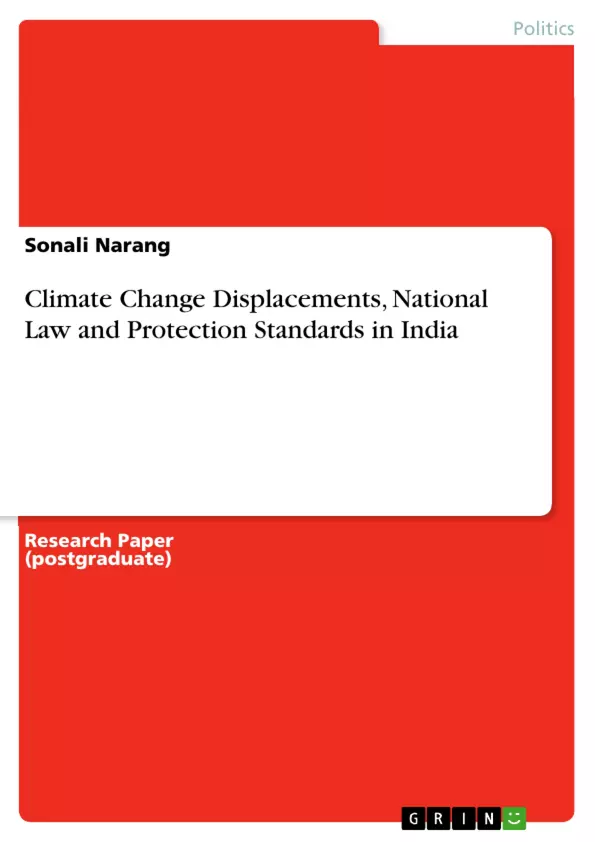This paper will examine how the national law initiatives can be broadened and revived with upcoming ‘climate refugees’.
India’s geopolitical position in South Asia is popular for asylum seekers, migrant workers and future flows of climate refugees. Without the legal recognition, refugees in India have difficulties in accessing basic facilities such as employment, medical facilities, education and health care.
It is now widely known that climate change will significantly affect India. There are few studies available on how climate change is going to affect the migration of people. It has been claimed that 70,000 people of the 4.1 million living in the Indian part of the Sundarbans islands would be rendered homeless by 2020. India is home to nearly 190,000 refuges originating from various countries around the world. Yet, refugee protection in India is regulated solely at policy level by national administrative authorities. There are no laws that distinguish between refugees and foreigners in India. Thus, there is a clear gap within the law which requires immediate action and attention. India needs to develop its own Refugee Protection laws.
Frequently asked questions
What is the main topic of this document?
This document discusses the legal framework and challenges surrounding climate refugees in India. It examines existing domestic laws, international protection instruments, and gaps in these provisions, focusing on cross-border climate-induced displacement/migration.
What are the key challenges regarding refugee protection in India?
India lacks a uniform national law to deal with its refugee population, and it's not a signatory to the 1951 Refugee Convention or its 1967 Protocol. This absence of codified protection strategies and specific national laws on aliens results in ambiguous refugee rights.
How significant is climate-induced migration to India?
Climate change may displace millions of people both internally and across national borders, with significant implications for India. Estimates suggest tens of millions could be displaced within India and from neighboring countries like Bangladesh due to climate-related disasters.
How has India historically dealt with refugee populations?
India has absorbed several flows of population throughout history, often integrating them into a multi-ethnic society. Past instances include refugees during the Partition, from Tibet, and from East Pakistan/Bangladesh at various times. Initially, there was a Ministry of Rehabilitation, which later became a division under the Ministry of Home Affairs.
What legal instruments currently govern the treatment of foreigners, including refugees, in India?
The Foreigners Act of 1946, a colonial-era legislation, defines a "foreigner" as anyone who is not a citizen of India, covering refugees as well. This Act vests broad powers in the Central Government to control and even expel foreigners.
What constitutional protections are available to foreigners in India?
Foreigners in India are entitled to some constitutional protections, including Article 14 (equality before the law) and Article 21 (right to life and personal liberty). Courts have interpreted these articles to provide a degree of protection to refugees.
What role have Indian courts played in refugee protection?
Indian courts have, on occasion, adopted a more humane approach to protect refugees' rights. For example, the Supreme Court has suggested that refugees are a class apart from foreigners, deserving protection under Article 21. Courts have also, in some cases, protected against forced repatriation and deferred to the UNHCR.
What initiatives have been taken towards formulating a refugee law in India?
The National Human Rights Commission (NHRC) has advocated for a national refugee policy in line with the 1951 UN Convention and its 1967 Protocol, but tailored to the Indian context. An Eminent Persons Group (EPG), supported by UNHCR, approved a model national law in 1997.
What are the potential implications of climate change for migration to India from Bangladesh?
Climate change is expected to exacerbate migration from Bangladesh to India due to increased frequency and severity of disasters, water scarcity, and sea-level rise. Some projections estimate tens of millions of climate refugees may originate from Bangladesh.
What future actions are recommended in the document regarding India's refugee policy?
The document suggests India should broaden its national legal regime for refugee protection, develop a regional framework for accommodating climate migrants in South Asia, and include moral-emotional aspects, ensuring compassion and care for displaced populations.
- Arbeit zitieren
- Dr Sonali Narang (Autor:in), 2017, Climate Change Displacements, National Law and Protection Standards in India, München, GRIN Verlag, https://www.grin.com/document/375954



